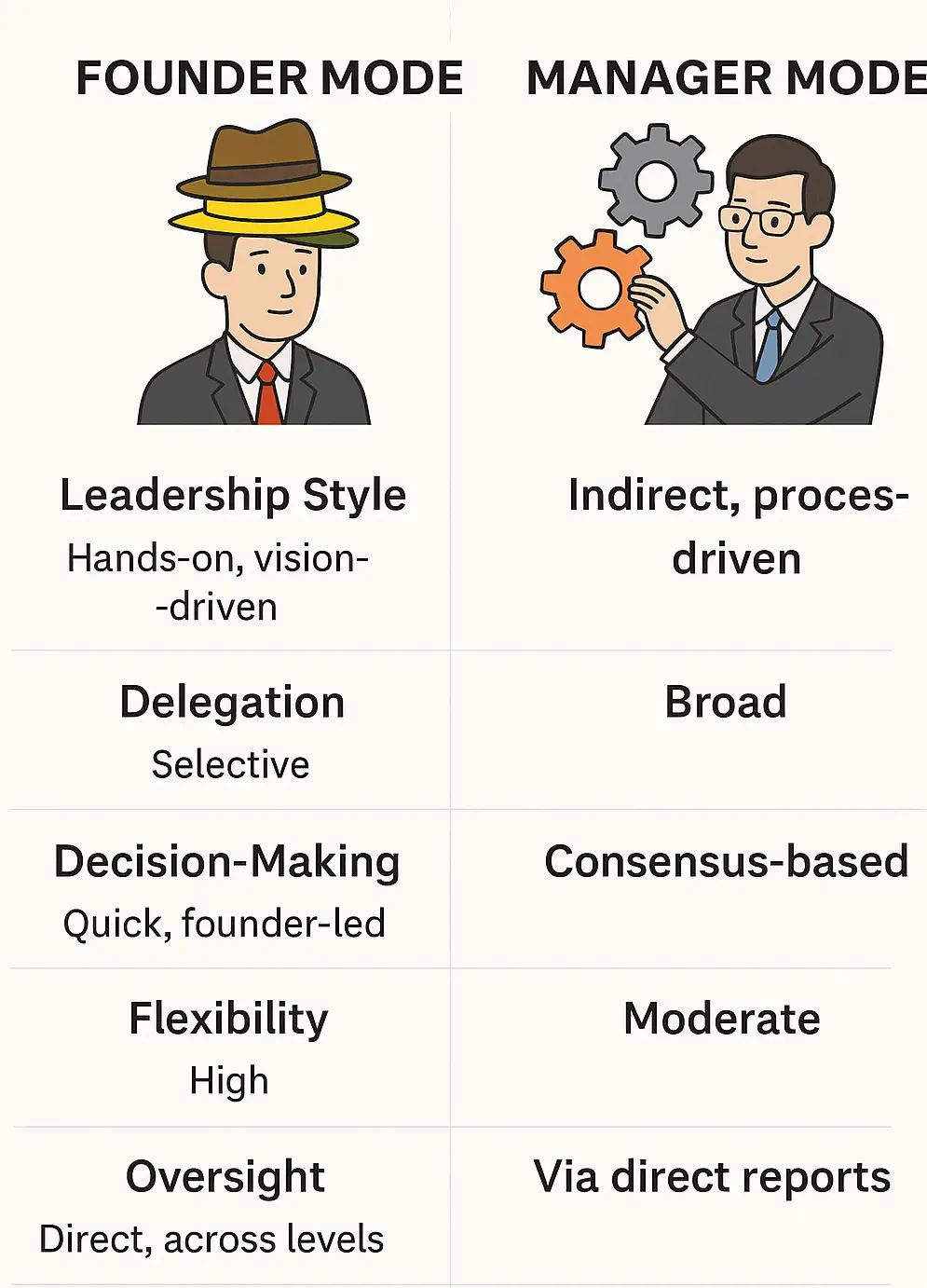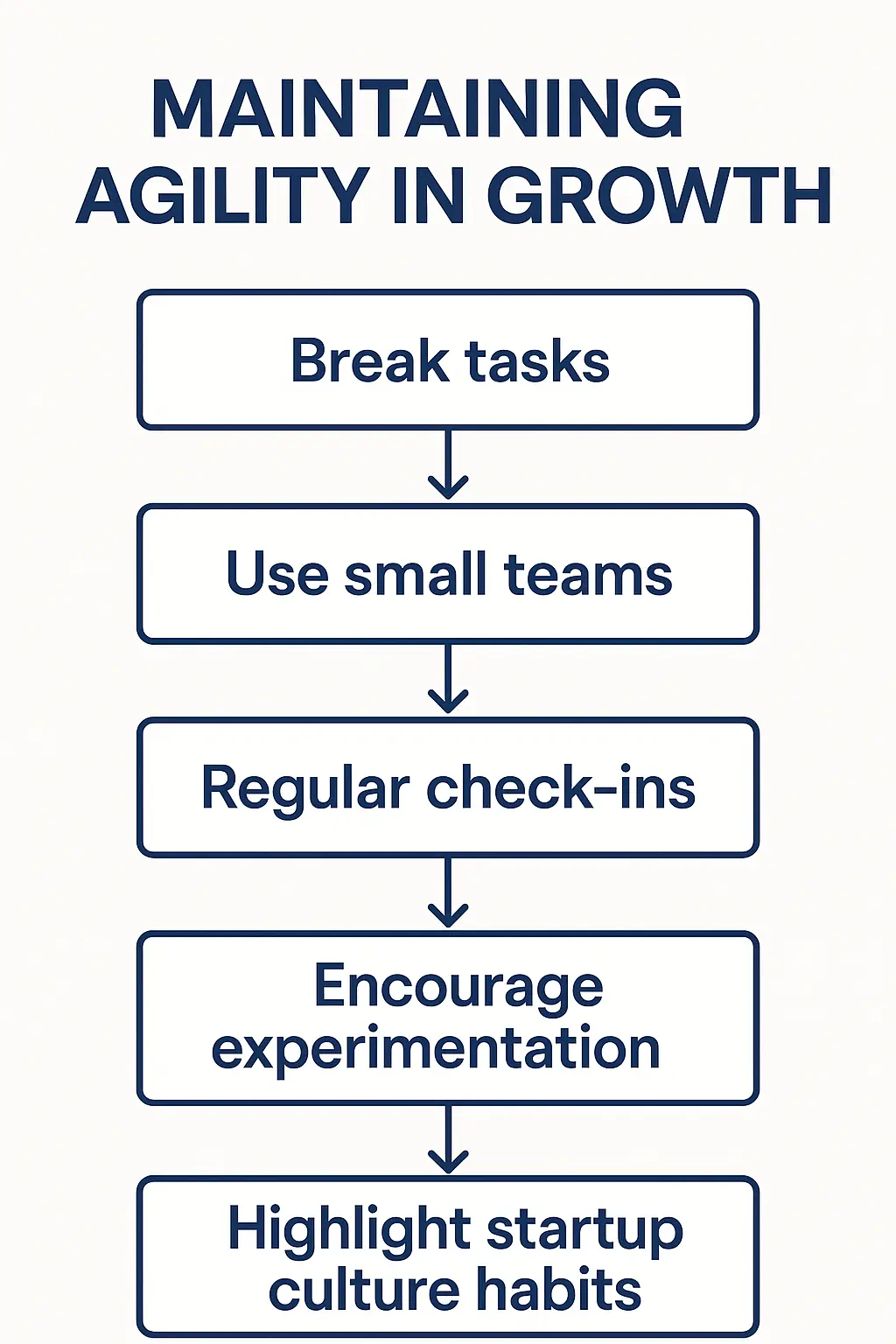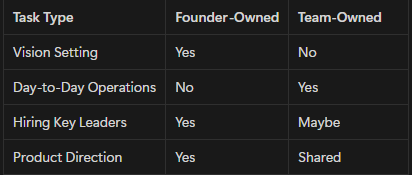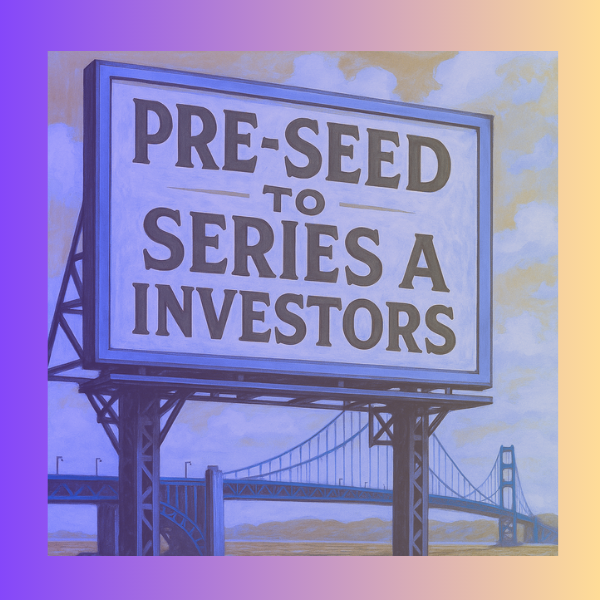Are you in founder mode?
You've probably seen that phrase circulating in startup and VC circles (and if you haven't, then you better add it to your list of startup slang now!).
Founder mode is a hands-on way of running a company where the founder gets deeply involved with all parts of the business instead of just giving orders from the top.
This approach is very different from the traditional manager mode, which trusts managers to handle things while the founder steps back.
Founder mode often means the founder talks directly with people at every level of the company and stays close to the details.
Many well-known founders, like Steve Jobs and Brian Chesky, have used this style to keep their companies creative and fast-moving, even as they get bigger.
People are paying more attention to founder mode because it's showing that founders don't have to stop leading just because their companies grow.
Founder Mode Meaning and Origins
Founder mode is a way of working where the founder is deeply involved in the company’s day-to-day activities, shaping its early growth with direct decisions and actions.
The phrase has become important in startup culture and is often discussed in contrast to more traditional management styles.
Defining Founder Mode
Founder mode describes a management style where the founder takes a hands-on approach.
Instead of just delegating tasks or only working with other top leaders, founders spend time solving problems, making key decisions, and interacting with all parts of the business.
This approach allows founders to spot issues quickly and respond to changes as they happen.
It's common in early-stage startups, where every detail matters and big risks must be taken.
Some people see founder mode as essential for building a strong company culture and pushing forward new ideas.
This style is different from "manager mode," which is about delegating tasks and focusing on more routine operations.
Key features of founder mode:
- Direct involvement in daily tasks
- Quick decision-making
- A focus on the company’s mission and vision
- Control over details
Origin of the Term
The term "founder mode" became popular thanks to Paul Graham, the co-founder of Y Combinator.
In September 2024, Paul Graham wrote an essay describing the value and impact of working in founder mode, especially in startups.
His essay responded to talks by other entrepreneurs, such as Brian Chesky from Airbnb, and sparked conversations in the tech world.
Paul Graham argued that founder mode helps companies grow by allowing founders to use their unique knowledge and passion for the business.
He contrasted this with traditional "manager mode," often seen in larger companies.
The spread of Paul Graham’s ideas on social media and startup blogs helped make founder mode a well-known concept.
Founder Mode Explained
Founder mode is about more than just working hard.
It’s about how a founder works and leads. Founders often set the direction for the entire company through their daily actions and direct feedback.
This method is seen as flexible, since the founder can shift priorities fast and solve problems right away.
In founder mode, the founder is often the main driver of innovation. He or she may write code, design products, or help close sales.
This active style is suited to small teams and early-stage companies, where changes happen quickly.
Founder mode is not meant to last forever. As the company grows, shifting to a more "managerial" approach can help with long-term stability and scaling.
Distinguishing Founder Mode from Manager Mode
Founder mode and manager mode each shape how a company operates and grows. They differ in leadership style, how work is delegated, and the way decisions are made.
Core Differences
Founder mode is driven by the creator's vision and hands-on engagement across many areas. Founders work directly with teams, often crossing layers of the organization to solve problems or drive progress. This mode is common in startups or when founders want to keep their influence strong as companies grow.
Manager mode focuses on established processes and structure. Here, leaders operate through set channels, limiting their involvement mainly to their immediate direct reports. The organization becomes more modular, with each part expected to run mostly on its own. This helps larger organizations work consistently, but sometimes reduces flexibility and innovation.
The main differences:
- Founder mode: Deep involvement, vision-driven, flexible.
- Manager mode: Indirect involvement, process-driven, structured.
Role of Delegation
In founder mode, delegation is selective and often limited. Founders keep certain decisions and projects for themselves, especially those that shape the company's core direction. They may skip levels in the hierarchy, working directly with any team member regardless of rank when needed.
In manager mode, delegation is the main tool for scaling. A manager hands off authority and responsibility to trusted leaders, expecting them to execute independently. The boundaries between teams and departments are more defined, and leaders avoid micromanaging details to let others prove their abilities.

Decision-Making Styles
Founder mode uses quick, centralized decision-making. The founder often makes tough calls themselves or gathers feedback from many levels before deciding. This can speed up innovation and adjustment, but sometimes creates bottlenecks if all decisions need the founder's approval.
Manager mode relies more on structured, distributed decision-making. Teams and department leaders are empowered to decide within their own areas, following guidelines or processes. This tends to make things run smoother at scale, but can cause delays if coordination between teams is needed.
Key points:
- Founder mode: Fast, founder-led, adaptive.
- Manager mode: Consensus-based, process-driven, consistent.

Key Principles of Operating in Founder Mode
Operating in founder mode emphasizes active involvement, staying connected to the company's core mission, and fostering a flexible, responsive organization. Effective founders combine decisive action, a hands-on approach, and a focus on company culture.
Hands-On Leadership
Founder mode means the founder is directly involved in big decisions and the daily work that keeps the company moving. He or she does not simply delegate all tasks but maintains oversight, especially in crucial areas like product development, hiring key staff, and big partnerships.
Hands-on leadership often involves “skip-level” meetings, where the founder talks directly with teams and employees, not just their direct reports. This can help catch issues earlier and boost creativity. Being hands-on helps founders catch problems that might otherwise go unnoticed.
Choosing where to dive in and where to trust others is important. Too much control can turn into micromanaging, while too little can lead to losing touch with reality. The founder’s direct effort acts as a signal to the rest of the team about what truly matters.
Maintaining Vision and Agility
Founders in this mode keep the company focused on its original purpose, even as it grows. They hold a clear vision and are quick to adapt when markets or technologies shift. Instead of following strict routines or only thinking in terms of the org chart, they prioritize clear goals and customer value.
This approach allows for fast decisions and quick turns when plans need to change. When team members see the founder adapting, they feel safe experimenting and trying new ideas.
To aid vision and agility, founders often:
- Set short, clear priorities.
- Hold regular check-ins to spot changes in the market.
- Encourage questions if the company drifts from its north star.
Maintaining agility prevents the company from becoming slow or stuck in old ways.

Direct Company Engagement
Operating in founder mode breaks the tradition of only working through layers of management. Founders regularly communicate with people at all levels, from entry-level employees to top leaders.
This can involve:
- Running retreats with key staff, regardless of their title.
- Listening to employee feedback firsthand.
- Visiting different teams to ask about challenges and opportunities.
A founder’s direct engagement shows commitment and keeps information flowing. Employees are more likely to share honest feedback with someone who takes time to understand their work. The speed of problem-solving increases when founders have an accurate, up-to-date picture of what’s working and what needs help.
Cultural Impact
The way a founder acts becomes the baseline for the culture of the business. Founder mode reinforces a “scrappy,” solution-focused mindset among teams. People watch how the founder handles setbacks, hires new talent, or faces tough choices.
Key cultural outcomes of founder mode include:
- A bias toward action and learning.
- High standards for quality and honesty.
- A willingness to experiment and adjust quickly.
Culture in founder-led companies often remains closer to its early roots, even as the business grows. This helps employees stay motivated and makes the company more attractive to new hires who want to build something meaningful. The founder’s visible commitment to values and goals helps keep people focused and united through each stage of growth.
Real-World Examples of Founder Mode
Founder mode can look different depending on the company and leader. Some founders stay very hands-on, driving major changes and decisions. Others use their deep connection to their company to solve problems quickly and shape culture.
Airbnb and Brian Chesky’s Leadership
Brian Chesky stepped back into founder mode at Airbnb when his company started losing direction. Instead of relying heavily on outside managers, Chesky got involved in daily operations and decision-making. This direct approach allowed him to identify problems early and fix them before they grew.
He spent more time listening to guests and hosts and used their feedback to improve Airbnb’s service. By focusing on the core vision, he helped rebuild the company's culture and improve financial results. Chesky’s leadership is often seen as a textbook example of how founder mode can put a company back on track.
It's worth noting that while Chesky's leadership style embodies what Paul Graham later termed "founder mode," Chesky himself never called it that. The term was coined by Graham in response to Chesky's talks about his management philosophy. Chesky's approach is often seen as a textbook example of how this hands-on leadership style can put a company back on track.
Influence of Paul Graham
Paul Graham, co-founder of Y Combinator, didn't just build companies in founder mode; he promoted the idea in the startup world. Graham believes that founders who are closely involved know their company the best. He argues they can make faster and more informed choices than outsiders.
Graham’s essays often encourage founders to avoid outsourcing the hard decisions just because it seems "professional." Instead, he points out that firsthand knowledge is an advantage, especially in early-stage companies. Many startups in Y Combinator’s program use Graham’s advice to stay closely involved in their business, at least until growth makes it necessary to delegate more.
Other Notable Founder-Led Companies
Several major companies have followed versions of founder mode, especially during key moments. For example, Steve Jobs at Apple was known for intense personal involvement in product design and company decisions. Jeff Bezos at Amazon often took charge of new initiatives and didn’t fully step back even as the company grew.
Elon Musk at Tesla and SpaceX is also very involved in key engineering and product choices. These founders use their firsthand knowledge and strong vision to keep the company focused and moving fast. While there are risks like burnout or bottlenecks, the benefits often include faster innovation and a clearer mission.

Challenges and Limitations of Founder Mode
Founder mode brings intensity and vision to a startup but also comes with real difficulties. Persistent hands-on involvement from founders can cause issues with growth, decision-making, and hiring as a company expands.
Scalability Issues
When founders manage every detail, scaling becomes a bottleneck. As teams grow, the direct oversight model does not keep up. Founders have limited time and energy, so trying to manage larger systems often leads to overwhelm or gaps in oversight. Tasks take longer to complete due to this centralization.
Rapid company growth demands new processes and more structure. Founders may find it hard to let go of control or delegate crucial responsibilities. This can slow down innovation at different levels and make it difficult for leaders to shift from informal channels to formal management systems.
Risks of Micromanagement
High involvement can inspire teams, but can also cross over into micromanagement. When a founder tries to control all decisions, employees lose autonomy. This micromanagement can reduce motivation and make team members hesitant to share ideas or take initiative.
Innovation requires space for experimentation and failure. If founders are overly hands-on, employees may fear mistakes and stick to only what is approved. Over time, this creates a culture of dependency, which makes it harder to retain creative talent.
Micromanagement can also lead to burnout on both sides. Founders working long hours can become exhausted, while employees feel they are being watched and second-guessed instead of trusted to execute.
Talent and Hiring Dynamics
Working for a founder-led company often means dealing with intensity and high expectations. Not every employee thrives in such an environment. The hiring process must focus on finding people who align with the founder’s vision, tolerate uncertainty, and are self-driven.
Selecting the wrong talent can have serious consequences. Employees who do not adapt quickly will struggle. This misalignment puts extra pressure on teams and can increase turnover. Skills like adaptability, clear communication, and problem-solving are essential for success.
Behavioral interviews, work samples, and even psychometric testing are helpful tools for screening candidates. Cultural fit must be assessed alongside technical skills to ensure new hires will work well under close founder involvement.
Gender-Related Challenges
An important consideration in founder mode discussions is that women founders often face different challenges when implementing this leadership style compared to their male counterparts.
Women founders have reported that the same hands-on, direct approach that is celebrated when used by male founders may be perceived differently when employed by women, potentially facing criticism for being "too controlling" or "micromanaging." This highlights the need for greater awareness of how gender dynamics can affect the reception and effectiveness of founder-mode leadership styles.
Maintaining Founder Mode Through Growth
Founders often face challenges as their companies expand. Staying involved, keeping teams fast-moving, and shifting leadership approaches all play a role in steady growth.
Retaining Agility in Larger Teams
As teams get bigger, companies often become slower and less flexible. Founder mode encourages leaders to keep decision-making quick and communication open. This means breaking down large tasks into smaller pieces and using smaller groups to solve problems.
Regular check-ins, focused meetings, and clear priorities help avoid confusion. Digital tools like shared documents or chat apps let everyone stay updated. Leaders can set the example by tackling challenges head-on and showing that speed still matters.
Maintaining a startup mindset is key. Even simple routines like celebrating small wins or allowing new ideas from anyone in the company help keep energy high.
Balancing Delegation
Delegation changes as an organization grows. Founders must decide which tasks need their involvement and which should be handled by others. This often means letting go of less critical tasks so they can focus on areas like vision, values, or key strategy.
A simple way to decide is using a table to organize activities:

Open discussions and clear expectations help the team feel trusted. Setting clear outcomes, but allowing flexibility on how to get there, supports long-term growth.
Transition Strategies
Changes in leadership style become necessary as the team grows. A founder may start out handling everything, but must shift to building a strong leadership group around them.
Gradually increasing others’ responsibility builds confidence on both sides. Documenting core values and processes helps the company keep its identity as it expands.
Mentorship and training programs teach new managers how to lead with the same passion as the founder. Regular feedback sessions between founders and the team help spot and fix problems early. This ensures that the founder’s vision stays at the heart of company decisions.
The Future of Founder-Led Innovation
As startups navigate an increasingly complex business landscape, the debate between founder mode and manager mode continues to evolve. What's clear is that there's no one-size-fits-all approach. Successful companies often blend elements of both styles depending on their stage, Industry, and unique challenges.
The AI reshuffle and rapid technological change make the agility and vision of founder mode particularly relevant today. Founders who can maintain their hands-on approach while building scalable systems often create the most innovative and resilient companies.
However, the key lies in knowing when to dive deep and when to delegate, when to break convention, and when to build structure.
For entrepreneurs exploring these leadership dynamics, understanding founder mode isn't just about management theory; it's about finding the right balance for your company's unique journey.
At Everything Startups, we recognize that every founder's path is different, and the resources, insights, and community connections you need to succeed should reflect that diversity.
Whether you're operating in full founder mode, transitioning to a hybrid approach, or building your management philosophy from scratch, the entrepreneurial ecosystem continues to offer new lessons and opportunities for those willing to stay engaged and adaptive.
The conversation around founder mode reminds us that building a successful startup is about having the courage to lead authentically while remaining open to growth and change. As more founders share their experiences and challenge conventional wisdom, the startup community becomes richer and more nuanced, creating better paths forward for the next generation of entrepreneurs.








